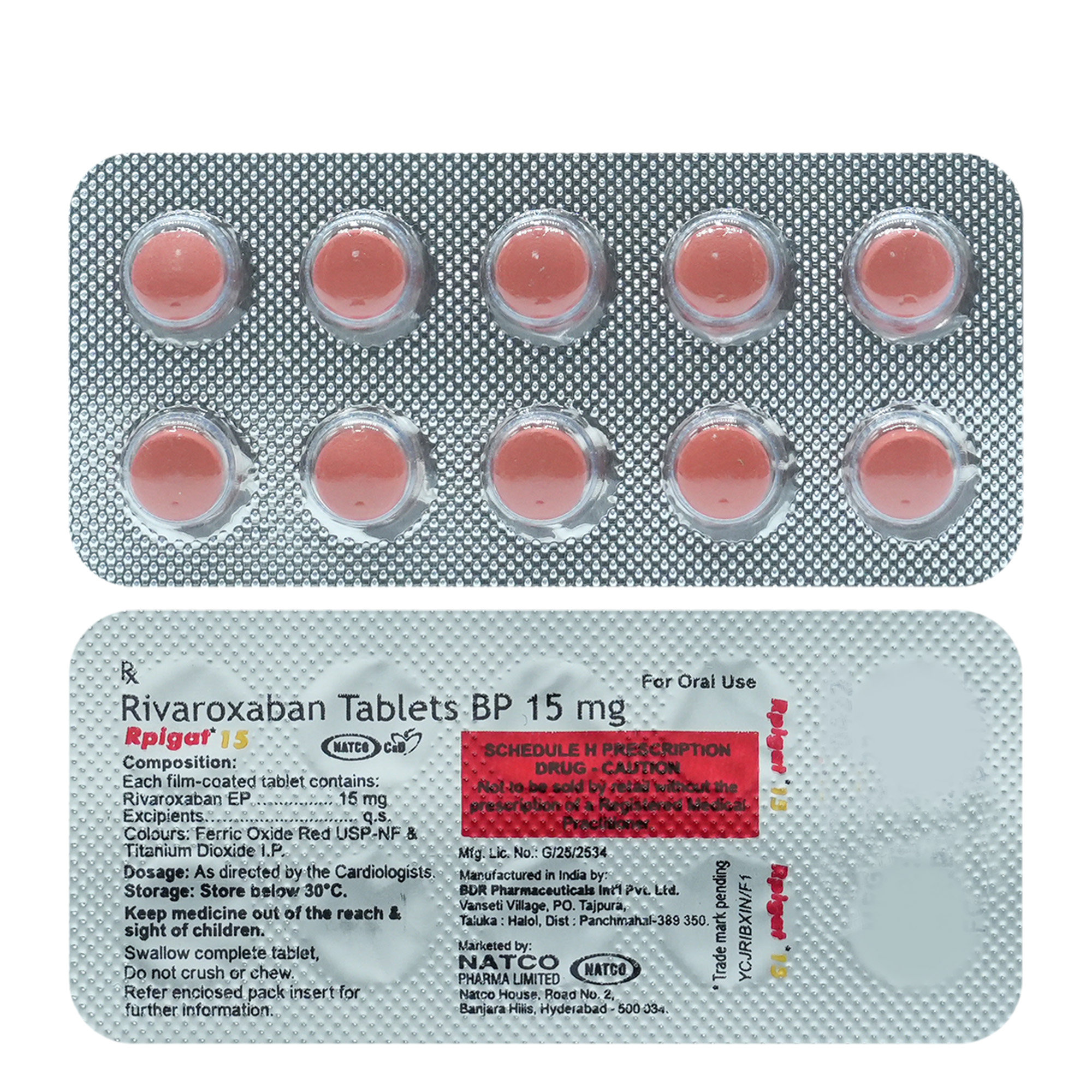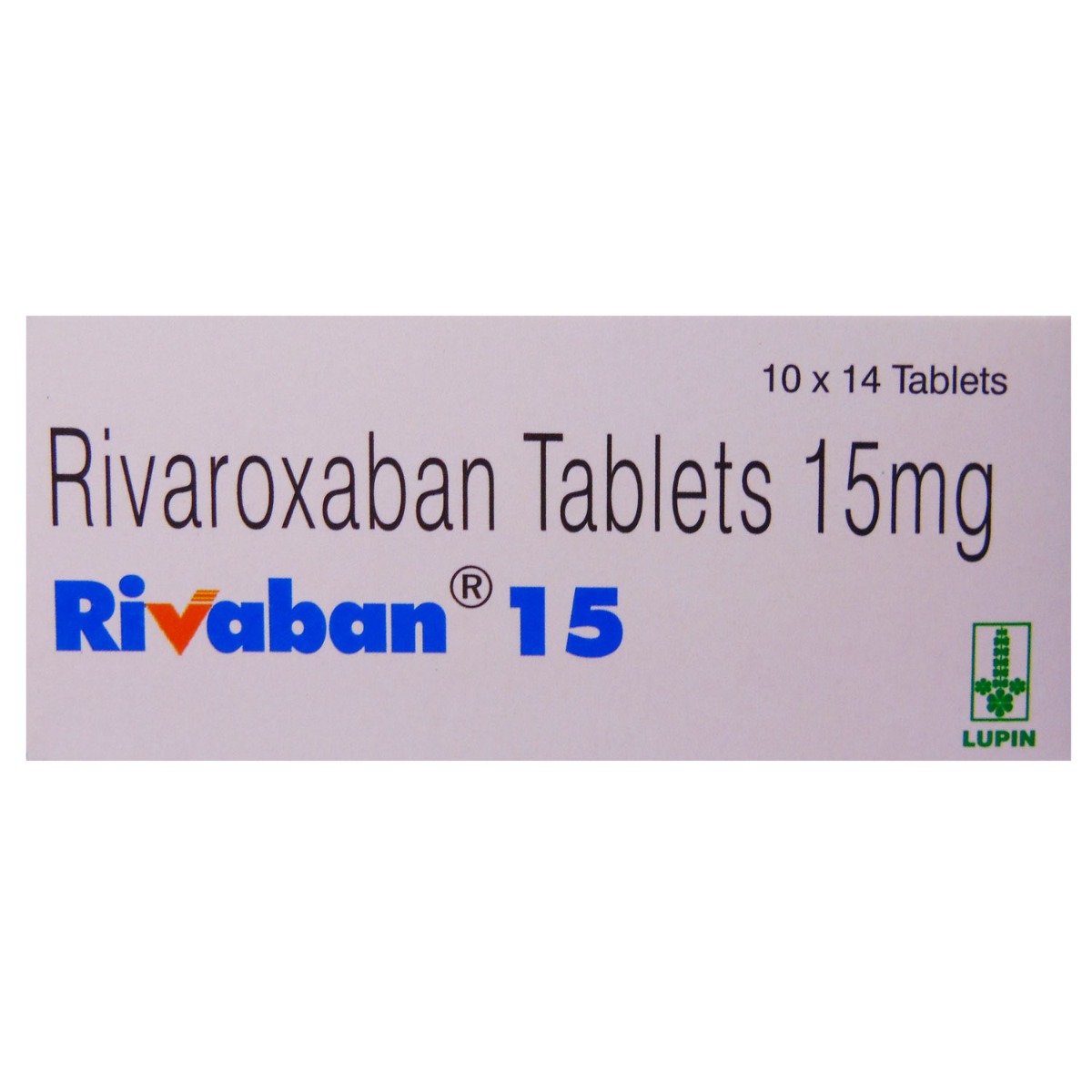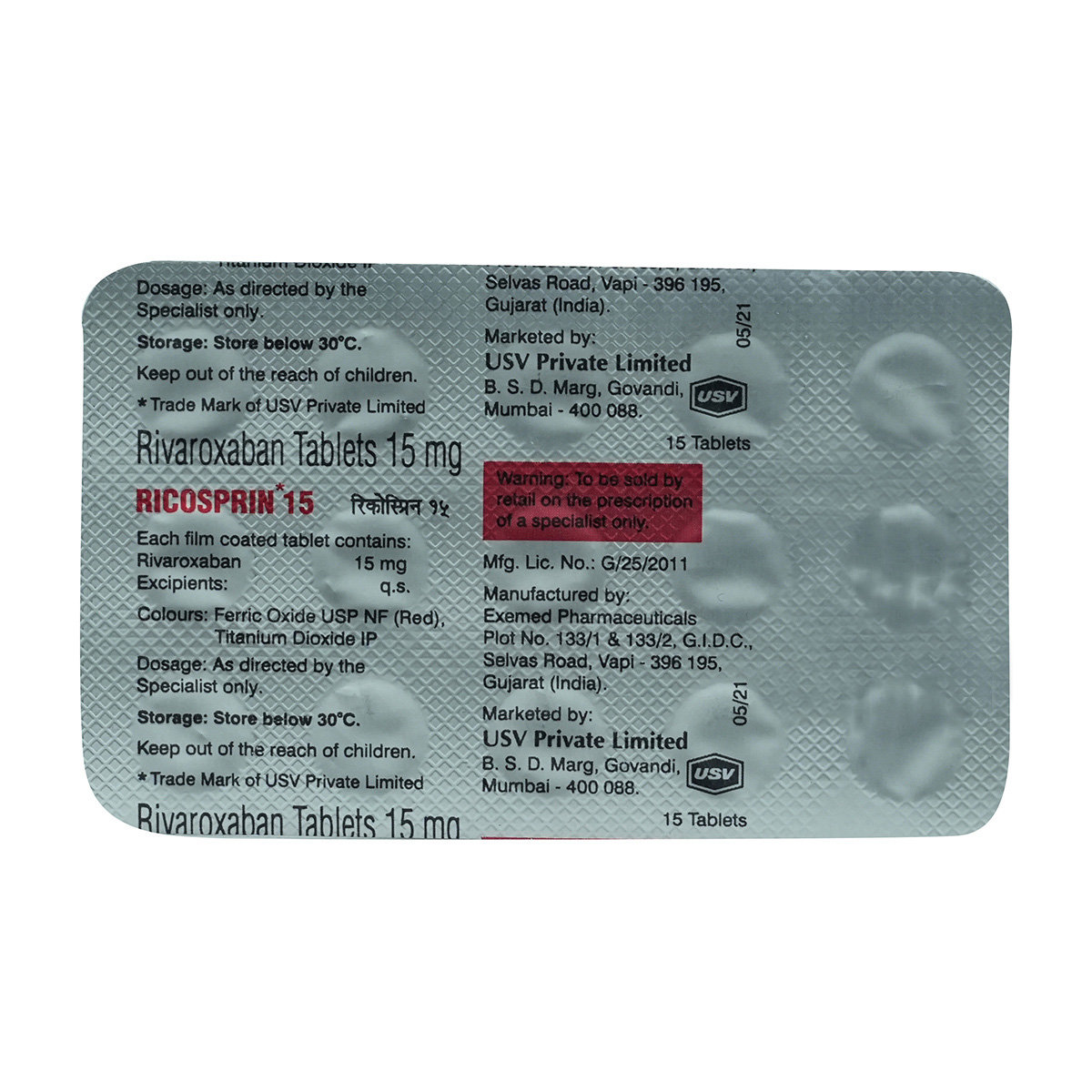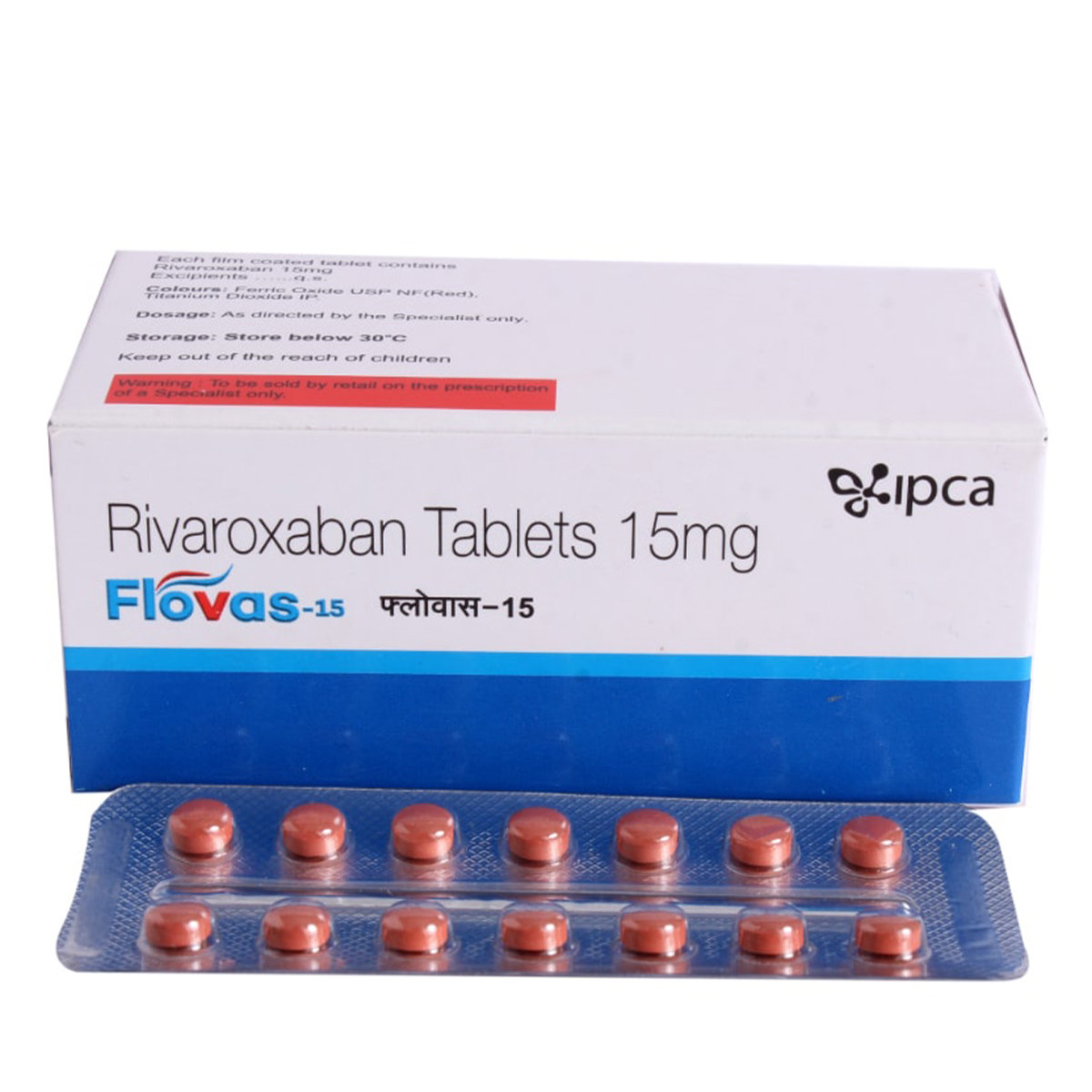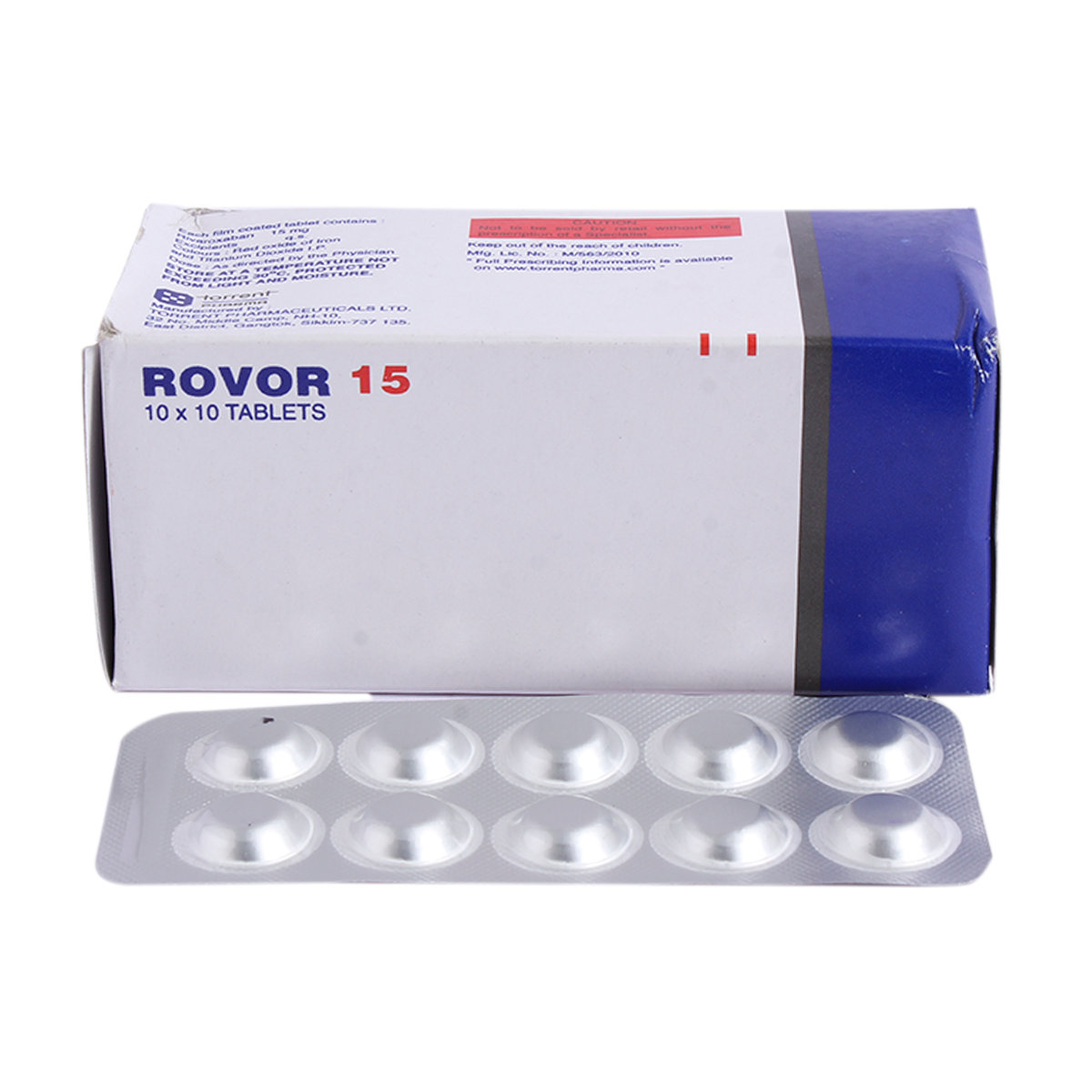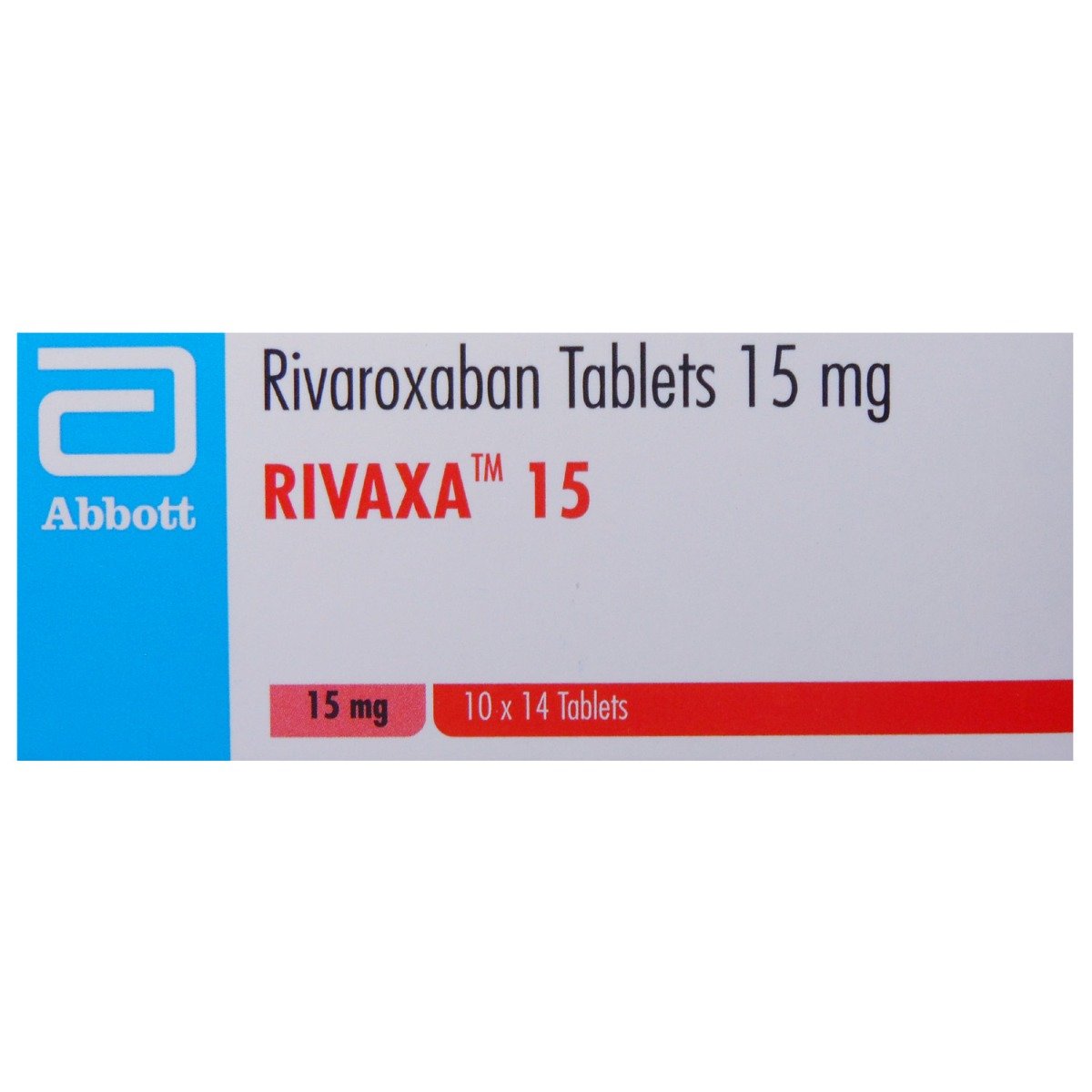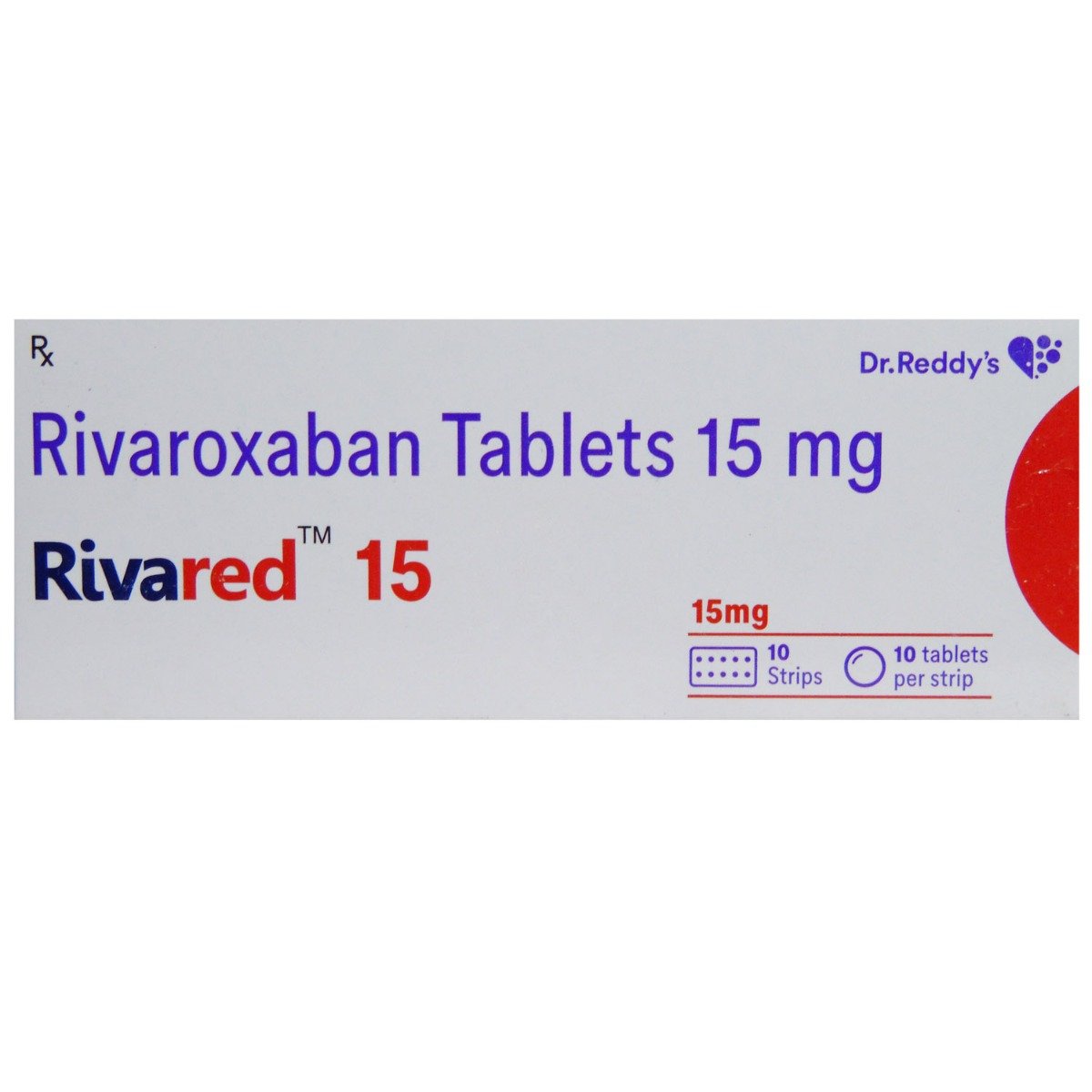RRB 15 mg Tablet 10's
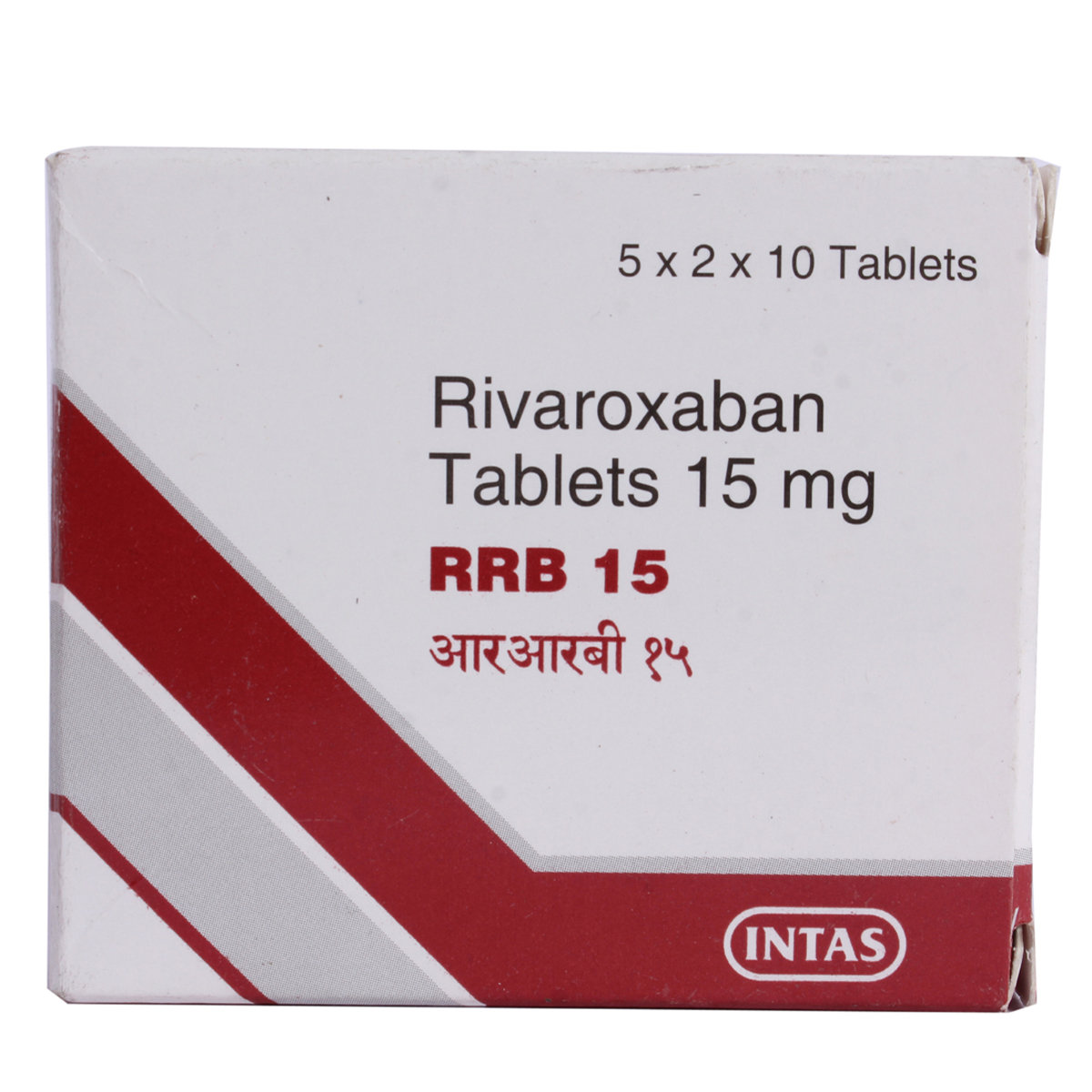
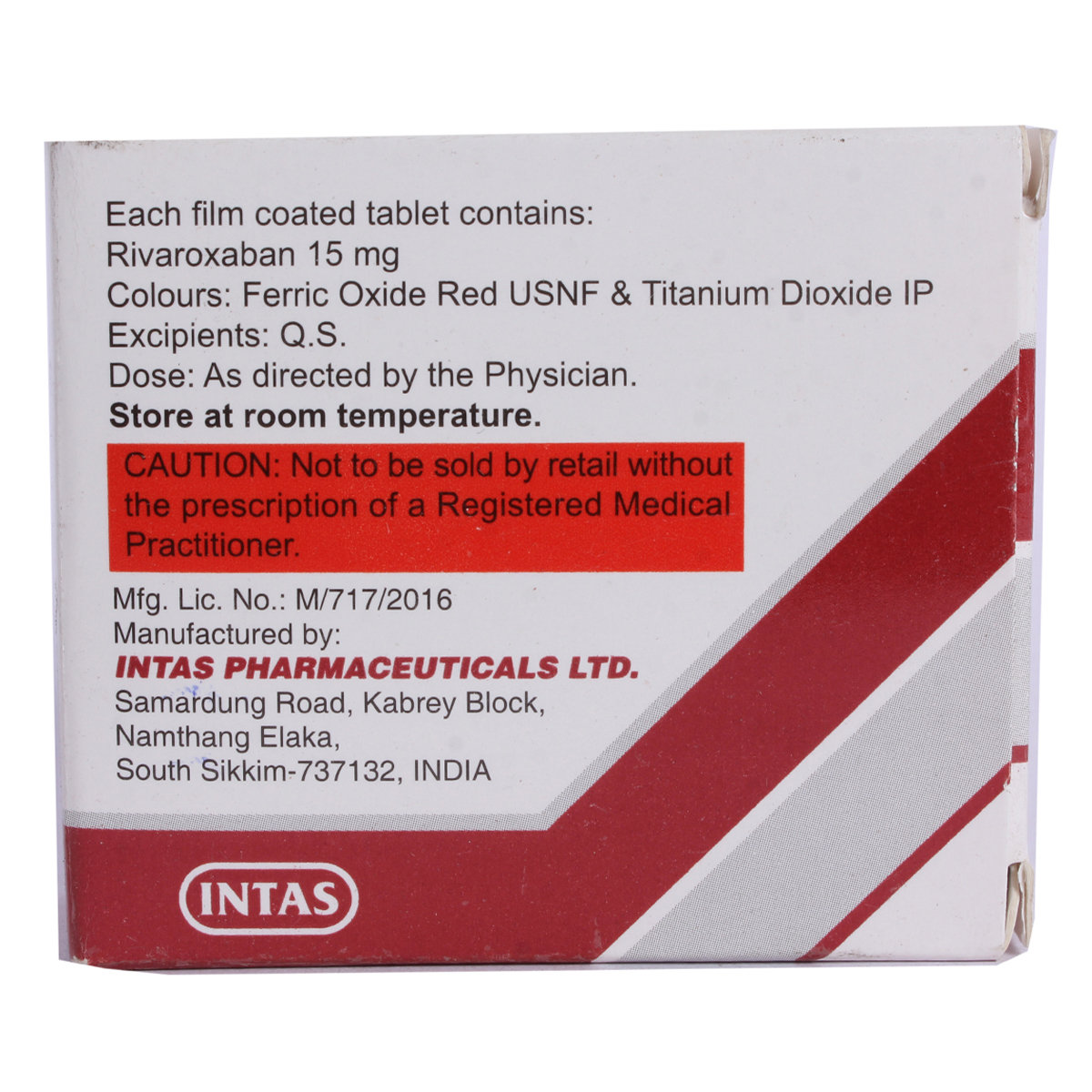
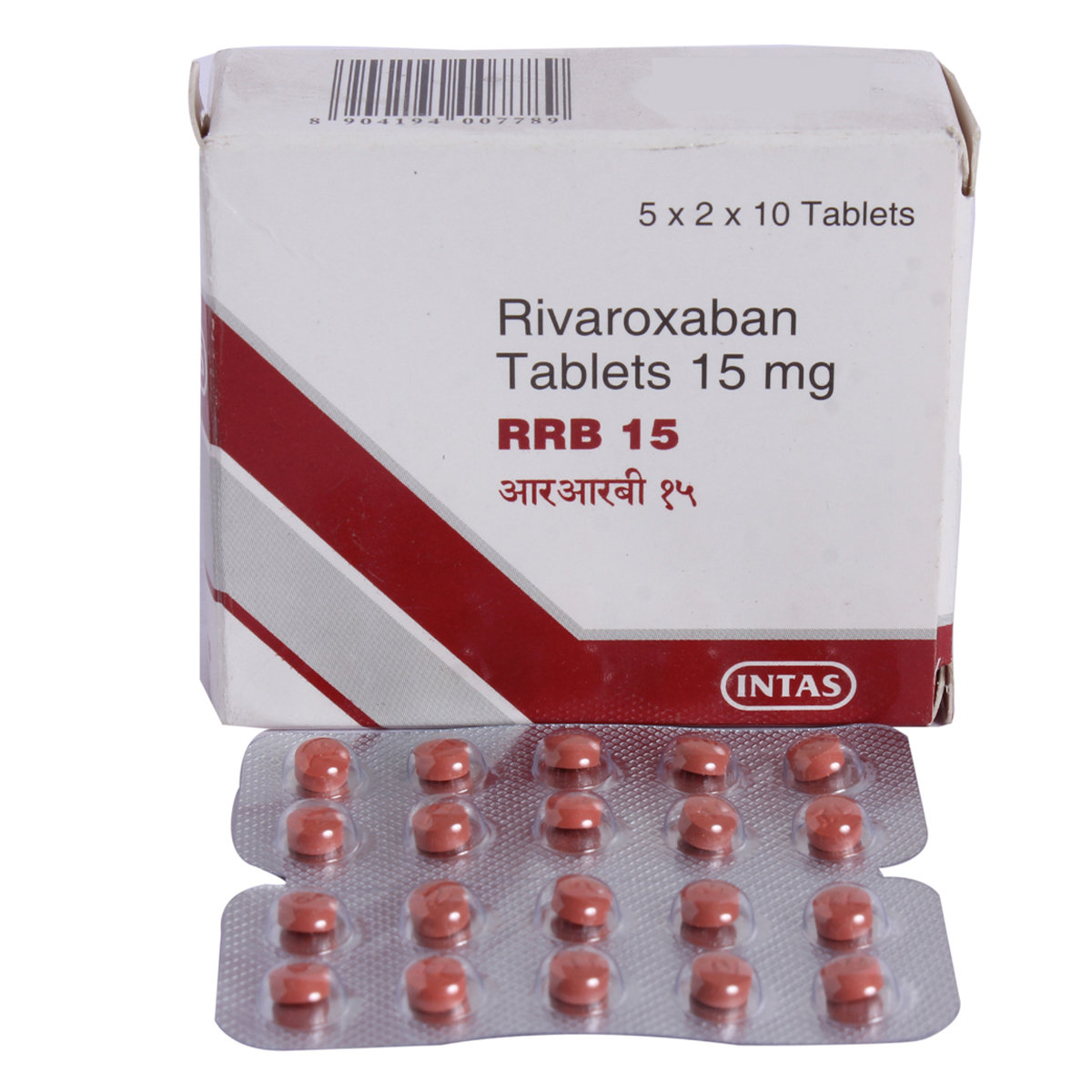



MRP ₹200
(Inclusive of all Taxes)
₹30.0 Cashback (15%)
Provide Delivery Location
Online payment accepted
 Prescription drug
Prescription drugWhats That
Composition :
Manufacturer/Marketer :
Consume Type :
Return Policy :
Expires on or after :
About Rrb 15 Tablet
Rrb 15 Tablet belongs to a class of drugs known as anticoagulants or blood thinner. Rrb 15 Tablet is primarily used to prevent and treat deep vein thrombosis (blood clots in leg veins) and pulmonary embolism (blood clots in the lung) by reducing blood clot formation. Deep vein thrombosis is a medical condition in which blood clots form in deep veins usually in the legs. Pulmonary embolism is a condition in which a blood clot blocks the arteries in the lungs.
Rrb 15 Tablet contains Rivaroxaban, a blood thinner that works by inhibiting the production of clotting factors by decreasing the action of vitamin K. This prevents the conversion of fibrinogen (soluble protein) to fibrin (insoluble protein), thereby preventing blood clots formation.
Take Rrb 15 Tablet as prescribed. You are advised to take Rrb 15 Tablet for as long as your doctor has prescribed it for you depending on your medical conditions. You may experience bleeding, anemia (low number of red blood cells), and nausea. Most of these side effects of Rrb 15 Tablet do not require medical attention and gradually resolve over time. However, if the side effects are persistent, reach out to your doctor.
If you are known to be allergic to Rrb 15 Tablet or any other medicines, please tell your doctor. If you are pregnant or breastfeeding, it is advised to consult a doctor before using Rrb 15 Tablet . If you have a stomach ulcer, kidney or liver problems, high blood pressure, or bleeding problems, inform your doctor before taking Rrb 15 Tablet . Talk to your doctor immediately if you are pregnant or breastfeeding.
Uses of Rrb 15 Tablet
Directions for Use
Medicinal Benefits
Rrb 15 Tablet belongs to a class of drugs known as anticoagulants or blood thinner. Rrb 15 Tablet is primarily used to prevent and treat deep vein thrombosis (blood clots in leg veins) and pulmonary embolism (blood clots in the lung) by reducing blood clot formation. Rrb 15 Tablet works by inhibiting the production of clotting factors by decreasing the action of vitamin K. This prevents the conversion of fibrinogen (soluble protein) to fibrin (insoluble protein), thereby preventing blood clots formation.
Storage
Drug Warnings
Rrb 15 Tablet should be used with caution in children. Prolonged use of Rrb 15 Tablet may cause hair loss. Regular blood tests are recommended while taking Rrb 15 Tablet to check the time taken for your blood to clot and the level of platelets (blood cells). If you are known to be allergic to Rrb 15 Tablet or any other medicines, please tell your doctor. If you are pregnant or breastfeeding, it is advised to consult a doctor before using Rrb 15 Tablet . If you have a stomach ulcer, kidney or liver problems, high blood pressure, or bleeding problems, inform your doctor before taking Rrb 15 Tablet . Talk to your doctor immediately if you are pregnant or breastfeeding.
Drug-Drug Interactions
Drug-Drug Interactions
Login/Sign Up
Co-administration of ruxolitinib and RRB 15 mg Tablet can increase the risk or severity of bleeding problems.
How to manage the interaction:
Co-administration of ruxolitinib and RRB 15 mg Tablet can lead to an interaction, it can be taken if advised by your doctor. However, if you experience any symptoms like unusual bleeding or bruising, dizziness, lightheadedness, red or black, tarry stools, coughing up or vomiting fresh or dried blood that looks like coffee grounds, severe headache, and weakness, consult the doctor immediately. Do not stop using any medications without a doctor's advice.
Co-administration of Bivalirudin and RRB 15 mg Tablet can increase the risk of unusual bleeding.
How to manage the interaction:
Co-administration of bivalirudin and RRB 15 mg Tablet can lead to an interaction, it can be taken if advised by your doctor. However, if you experience any symptoms like unusual bleeding or bruising, dizziness, lightheadedness, red or black stools, coughing or vomiting fresh or dried blood that looks like coffee grounds, severe headache, and weakness, consult the doctor immediately. Do not stop using any medications without a doctor's advice.
Co-administration of Conivaptan and RRB 15 mg Tablet can increase the blood levels of RRB 15 mg Tablet and increase the risk of bleeding complications.
How to manage the interaction:
Co-administration of Conivaptan and RRB 15 mg Tablet can lead to an interaction, it can be taken if advised by your doctor. However, if you experience any symptoms like unusual bleeding or bruising, dizziness, lightheadedness, red or black, tarry stools, coughing up or vomiting fresh or dried blood that looks like coffee grounds, or severe headache, and weakness, consult the doctor immediately. Do not stop using any medications without a doctor's advice.
Co-administration of Etodolac and RRB 15 mg Tablet can increase the risk of bleeding problems, including severe hemorrhage.
How to manage the interaction:
Co-administration of Etodolac and RRB 15 mg Tablet can lead to an interaction, it can be taken if advised by a doctor. However, if you experience any symptoms like unusual bleeding or bruising, dizziness, lightheadedness, red or black, tarry stools, coughing up or vomiting fresh or dried blood that looks like coffee grounds, severe headache, and weakness, consult the doctor immediately. Do not stop using any medications without a doctor's advice.
Coadministration of Naproxen and RRB 15 mg Tablet may increase the risk or severity of bleeding problems.
How to manage the interaction:
There may be a possible interaction between Naproxen and RRB 15 mg Tablet, but they can be taken together if they are prescribed by doctor. However, if you experience unusual bleeding or bruising, or have other signs and symptoms of bleeding such as dizziness; lightheadedness; red or black, stools; coughing up or vomiting fresh or dried blood that looks like coffee grounds; severe headache; and weakness, consult the doctor. Do not discontinue any medication without a doctor's advice.
Coadministration of carbamazepine and RRB 15 mg Tablet may reduce the blood levels of RRB 15 mg Tablet, which may reduce the treatment outcomes.
How to manage the interaction:
Although taking carbamazepine and RRB 15 mg Tablet together can possibly result in an interaction, it can be taken if your doctor has prescribed it. However, if you experience any unusual symptoms contact your doctor immediately. Do not stop using any medications without first talking to your doctor.
Co-administration of flurbiprofen and RRB 15 mg Tablet can increase the risk of bleeding problems.
How to manage the interaction:
Co-administration of flurbiprofen and RRB 15 mg Tablet can lead to an interaction, but it can be taken if your doctor has advised it. However, if you experience dizziness; lightheadedness, red or black, tarry stools, coughing up or vomiting fresh or dried blood that looks like coffee grounds, severe headache; and weakness contact your doctor immediately. Do not discontinue any medications without first consulting your doctor.
Coadministration of Ketoconazole and RRB 15 mg Tablet can increase the blood levels of RRB 15 mg Tablet and increase the risk of bleeding complications.
How to manage the interaction:
Taking ketoconazole and RRB 15 mg Tablet together can lead to an interaction, it can be taken if advised by a doctor. However, if you experience any symptoms like unusual bleeding or bruising, dizziness, lightheadedness, red or black, tarry stools, coughing up or vomiting fresh or dried blood that looks like coffee grounds, severe headache, and weakness, consult the doctor immediately. Do not stop using any medications without a doctor's advice.
Co-administration of Abciximab and RRB 15 mg Tablet can increase the risk of unusual bleeding.
How to manage the interaction:
Co-administration of Abciximab and RRB 15 mg Tablet can lead to an interaction, it can be taken if advised by your doctor. However, if you experience any symptoms like unusual bleeding or bruising, dizziness, lightheadedness, red or black, dark stools, coughing or vomiting fresh or dried blood that looks like coffee grounds, severe headache, and weakness, consult the doctor immediately. Do not stop using any medications without a doctor's advice.
Co-administration of Alteplase and RRB 15 mg Tablet can increase the risk of unusual bleeding.
How to manage the interaction:
Co-administration of Alteplase and RRB 15 mg Tablet can lead to an interaction, it can be taken if advised by your doctor. However, if you experience any symptoms like unusual bleeding or bruising, dizziness, lightheadedness, red or black, dark stools, coughing or vomiting fresh or dried blood that looks like coffee grounds, severe headache, and weakness, consult the doctor immediately. Do not stop using any medications without a doctor's advice.
Drug-Food Interactions
Drug-Food Interactions
Login/Sign Up
Diet & Lifestyle Advise
- Avoid making any changes in your diet without first talking to your doctor.
- Cranberry juice, grapefruit juice, noni juice, and pomegranate juice may interact with Rrb 15 Tablet and lead to unwanted side effects. Hence try to avoid these juices while taking Rrb 15 Tablet .
- Avoid drinking alcohol as it increases the risk of gastrointestinal ulcer/bleeding.
Side Effects of Rrb 15 Tablet
- Bleeding
- Anaemia (low number of red blood cells)
- Nausea
Habit Forming
Therapeutic Class
Product Substitutes
Drug-Diseases Interactions
Drug-Diseases Interactions
Login/Sign Up
FAQs
No, you are not recommended to stop taking Rrb 15 Tablet without consulting your doctor to worsen the condition. Therefore, take Rrb 15 Tablet for as long as your doctor has prescribed it.
No, Rrb 15 Tablet is not expected to cause weight gain. If you notice unexpected weight gain and think it is because of this Rrb 15 Tablet , immediately consult your doctor and inform him about it.
Rrb 15 Tablet has many beneficial effects, but it has the ability to make you bleed more than normal. Even with minor injuries as it decreases your ability to blood clotting. Sometimes Rrb 15 Tablet may cause severe bleeding that may be dangerous and may require urgent medical care. This risk may be increased in people taking Rrb 15 Tablet along with other blood thinner medicines.
Avoid taking grapefruit and grapefruit juice while taking Rrb 15 Tablet , and it contains compounds that slow down the metabolism of Rrb 15 Tablet and increase the activity leading to bleeding.
It is not known that Rrb 15 Tablet causes hair loss. Kindly contact your doctor.
Rrb 15 Tablet is a type of medicine known as an anticoagulant. Rrb 15 Tablet works by stopping a clotting factor called factor Xa from working. This thins your blood, so it takes longer to clot.
Drug-Drug Interactions Checker List
- WARFARIN
- ENOXAPARIN
- LOPINAVIR
- RITONAVIR
- ASPIRIN
- IBUPROFEN
- CARBAMAZEPINE
- PHENYTOIN
- ITRACONAZOLE
- KETOCONAZOLE
- FLUCONAZOLE
- ERYTHROMYCIN
- CLARITHROMYCIN
Special Advise
You should have regular platelet count, factor V assay, fibrinogen level test, prothrombin time test (PT or PT-INR) and the INR, or international normalized ratio to analyze your blood clotting time.
Disease/Condition Glossary
Deep vein thrombosis (blood clots in legs) is a medical condition in which blood clots form in deep veins usually in the legs. The symptoms include leg pain or swelling. Pulmonary embolism (blood clots in the lung) is a chronic condition that occurs as the blood clots break and travel to the lungs from deep veins in the legs or other parts of the body. The symptoms of pulmonary embolism include cough, chest pain, and shortness of breath.

Have a query?
Buy best Cardiology products by
Torrent Pharmaceuticals Ltd
Sun Pharmaceutical Industries Ltd
Lupin Ltd
Intas Pharmaceuticals Ltd
Cipla Ltd
Micro Labs Ltd
Macleods Pharmaceuticals Ltd
Abbott India Ltd
Ajanta Pharma Ltd
Ipca Laboratories Ltd
Eris Life Sciences Ltd
Mankind Pharma Pvt Ltd
Lloyd Healthcare Pvt Ltd
Dr Reddy's Laboratories Ltd
Glenmark Pharmaceuticals Ltd
Emcure Pharmaceuticals Ltd
Alembic Pharmaceuticals Ltd
Alkem Laboratories Ltd
East West Pharma India Pvt Ltd
USV Pvt Ltd
Zydus Healthcare Ltd
Aristo Pharmaceuticals Pvt Ltd
Elbrit Life Sciences Pvt Ltd
J B Chemicals & Pharmaceuticals Ltd
Zydus Cadila
Akumentis Healthcare Ltd
Alteus Biogenics Pvt Ltd
Hbc Life Sciences Pvt Ltd
Fusion Health Care Pvt Ltd
Troikaa Pharmaceuticals Ltd
La Renon Healthcare Pvt Ltd
Corona Remedies Pvt Ltd
Jubilant Lifesciences Ltd
Medley Pharmaceuticals Ltd
Knoll Healthcare Pvt Ltd
Msn Laboratories Pvt Ltd
Zuventus Healthcare Ltd
Cadila Pharmaceuticals Ltd
Blue Cross Laboratories Pvt Ltd
Lividus Pharmaceuticals Pvt Ltd
Morepen Laboratories Ltd
Ranmarc Labs
Shrrishti Health Care Products Pvt Ltd
Sanofi India Ltd
Steris Healthcare
Elder Pharmaceuticals Ltd
Primus Remedies Pvt Ltd
Unison Pharmaceuticals Pvt Ltd
Eswar Therapeutics Pvt Ltd
Knoll Pharmaceuticals Ltd
Tas Med India Pvt Ltd
Systopic Laboratories Pvt Ltd
Indiabulls Pharmaceuticals Pvt Ltd
Leeford Healthcare Ltd
Sinsan Pharmaceuticals Pvt Ltd
Biochem Pharmaceutical Industries Ltd
Cadila Healthcare Ltd
Azkka Pharmaceuticals Pvt Ltd
Nirvana India Pvt Ltd
Orsim Pharma
Prevego Healthcare & Research Pvt Ltd
Econ Healthcare
Elinor Pharmaceuticals (P) Ltd
FDC Ltd
Sunij Pharma Pvt Ltd
Nicholas Piramal India Ltd
Astra Zeneca Pharma India Ltd
Pfizer Ltd
Lia Life Sciences Pvt Ltd
Shine Pharmaceuticals Ltd
Elicad Pharmaceuticals Pvt Ltd
Indoco Remedies Ltd
Proqol Health Care Pvt Ltd
Vasu Organics Pvt Ltd
Biocon Ltd
Opsis Care Lifesciences Pvt Ltd
Johnlee Pharmaceuticals Pvt Ltd
Merck Ltd
Wockhardt Ltd
Auspharma Pvt Ltd
Ergos Life Sciences Pvt Ltd
Lakshya Life Sciences Pvt Ltd
Ordain Health Care Global Pvt Ltd
Pficus De Med Pvt Ltd
ALICAN PHARMACEUTICAL PVT LTD
RPG Life Sciences Ltd
Glynis Pharmaceuticals Pvt Ltd
Orris Pharmaceuticals
Samarth Life Sciences Pvt Ltd
Aprica Pharmaceuticals Pvt Ltd
Aretaeus Pharmaceuticals Pvt Ltd
Koye Pharmaceuticals Pvt Ltd
Neocardiab Care
Retra Life Science Pvt Ltd
Alniche Life Sciences Pvt Ltd
Alvio Pharmaceuticals Pvt Ltd
Arkas Pharma Pvt Ltd
Atos Lifesciences Pvt Ltd
Divine Savior Pvt Ltd
Metalis Lifesciences Pvt Ltd
Alcohol
Unsafe
You are recommended to avoid consumption of alcohol with Rrb 15 Tablet as it may increase the risk of bleeding.
Pregnancy
Caution
Tell your doctor before using Rrb 15 Tablet because it may cause harmful effects. So, only use in that condition when a doctor is prescribed.
Breast Feeding
Caution
Rrb 15 Tablet may pass into breast milk. Therefore consult your doctor.
Driving
Safe if prescribed
Rrb 15 Tablet usually does not affect your ability to drive or operate machinery.
Liver
Caution
Take Rrb 15 Tablet with caution, especially if you have a history of Liver diseases/conditions. The dose may be adjusted by your doctor as required.
Kidney
Caution
Take Rrb 15 Tablet with caution, especially if you have a history of Kidney diseases/conditions. The dose may be adjusted by your doctor as required.
Children
Unsafe
Rrb 15 Tablet is not approved for children. Therefore Rrb 15 Tablet is not safe for children.



